Discover 35 hidden attractions, cool sights, and unusual things to do in Mainz (Germany). Don't miss out on these must-see attractions: Mainz Cathedral, Deutschhaus, and Mainz Citadel. Also, be sure to include Osteiner Hof in your itinerary.
Below, you can find the list of the most amazing places you should visit in Mainz (Rhineland-Palatinate).
Table of Contents
Mainz Cathedral

Also known as: Mainzer Dom
10th-century sandstone religious edifice. Mainz Cathedral or St. Martin's Cathedral is located near the historical center and pedestrianized market square of the city of Mainz, Germany. This 1000-year-old Roman Catholic cathedral is the site of the episcopal see of the Bishop of Mainz.
Mainz Cathedral is predominantly Romanesque in style, but later exterior additions over many centuries have resulted in the appearance of various architectural influences seen today. It comprises three aisles and stands under the patronage of Saint Martin of Tours. The eastern quire is dedicated to Saint Stephen.
The interior of the cathedral houses tombs and funerary monuments of former powerful Electoral-prince-archbishops, or Kurfürst-Erzbischöfe, of the diocese and contains religious works of art spanning a millennium. The cathedral also has a central courtyard and statues of Saint Boniface and The Madonna on its grounds.
During the time of Mainz Archbishop Willigis (975-1011), the city of Mainz flourished economically, and Willigis became one of the most influential politicians of that time, ascending to regent of the empire between 991 and 994. In 975-976 shortly after his installation he ordered the construction of a new cathedral in the pre-Romanesque Ottonian architecture style. This new and impressive building was part of his vision of Mainz as the "second Rome".
This new cathedral was to take over the functions of two churches: the old cathedral and St. Alban's, which was the largest church in the area, belonging to a Benedictine abbey and serving as the burial ground for the bishops and other nobles, including Fastrada, a spouse of Charlemagne. Most of the synods and other important meetings were held at St. Alban's Abbey.
The new cathedral consisted of a double chancel with two transepts. The main hall was built in the typical triple-nave "cross" pattern. As was usual at that time no vault was included because of structural difficulties relating to the size of the building. Six towers rose from the church. A cloister was enclosed in the structure and a small freestanding church, St. Mary's Church, connected by a colonnade. This small church developed later into the collegiate church of St. Maria ad Gradus.
Sandstone was used as the primary building material for the cathedral. The inside was plastered white under the Archbishop Bardo, probably in the middle of the 10th century. During renovations ordered by Henry IV in the late 11th century, much of the outside was also plastered, but the cornices were left exposed in their original red and yellow. It is believed that the coloring of the cathedral was changed more times, but no further documentation of the coloring is available until record of the Baroque works.
The cathedral suffered extensive damage from a fire on the day of its inauguration in 1009. Archbishop Bardo (Bardo of Oppershofen) presided over the completion of the cathedral begun under Willigis. By 1037 the main portions of the body of Mainz Cathedral were complete. Willigis was buried in the second church he had initiated, St. Stephan's, in 1011.[1]
Address: Markt 10, 55116 Mainz
Deutschhaus
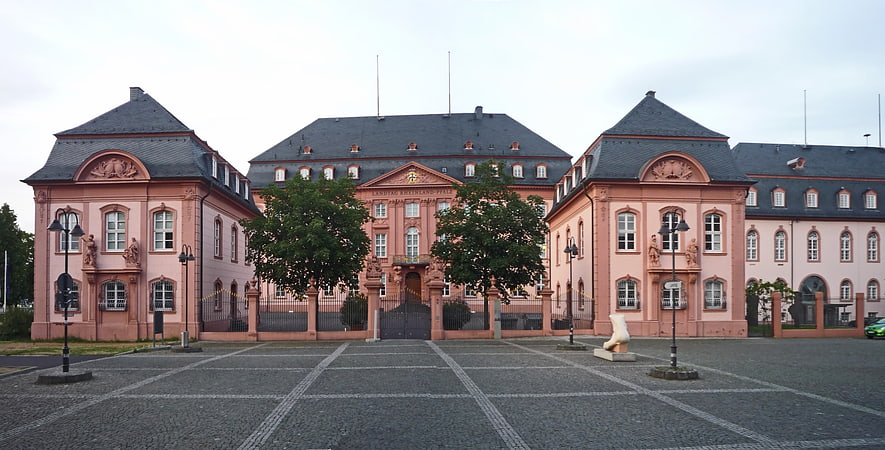
The Deutschhaus or Deutschordenskommende is a historical building in Mainz, western Germany, which is the seat of the Rhineland-Palatinate Landtag.[2]
Address: Deutschhausplatz 12, Mainz
Mainz Citadel

Also known as: Zitadelle Mainz
17th-century fortress with tours. The Mainzer Zitadelle is situated at the fringe of Mainz Old Town, near Mainz Römisches Theater station. The fortress was constructed in 1660 and was an important part of the Fortress Mainz.[3]
Osteiner Hof
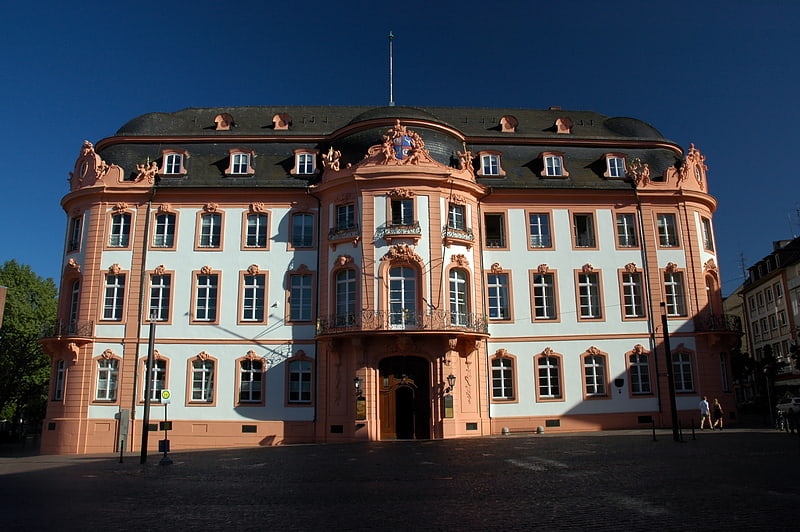
Mansion. The Osteiner Hof is one of several Baroque-era palatial mansions along Schillerplatz square in the German city of Mainz. The mansion, along the southern edge of the square, was built in 1747-1752 by architect-soldier Johann Valentin Thomann for Franz Wolfgang Damian von Ostein, brother of Johann Friedrich Karl von Ostein, who was prince-bishop of Mainz at that time.
Characteristic features for this building are the three round protrusions (risalits) at the front entrance and on the two corners. The building is lavishly decorated; for instance, the windows are framed by rococo-style cartouches symbolising the elements of air, earth and water. The classical gods Diana and Mars are shown on the cartouches framing the balcony doors.
The von Osteins, a dynasty of counts, were not able to make use of the mansion for very long. After the left bank of the Rhine was occupied by French Revolutionary armies, the mansion was appropriated by the state, and in 1798 it became the seat of a newly created département of France, Mont-Tonnerre.
The building continued to be used as a seat of government after the Napoleonic era, even gaining the nickname Gouvernement during the years 1854-1859, while emperor-to-be Wilhelm I was serving as military governor of Mainz. During the early days of the Franco-Prussian War (1870–1871), the Osteiner Hof served as military headquarters of a Prussian field marshal, Prince Frederick Charles of Prussia.
In 1914, then-military governor General Hugo von Kathen announced the start of World War I to the Mainz populace from the balcony of the Osteiner Hof. The mansion was destroyed by fire during World War II, but was restored in 1947-1948. From 1958 until 2014, the Osteiner Hof was in use by the Bundeswehr as military headquarters and officers' mess.
The Osteiner Hof plays an important part in the local carnival traditions. Every year, on 11 November at 11 past 11, the start of the carnival season is proclaimed from the balcony of the mansion.[4]
Address: Schillerplatz, 1, Mainz
St. Stephan
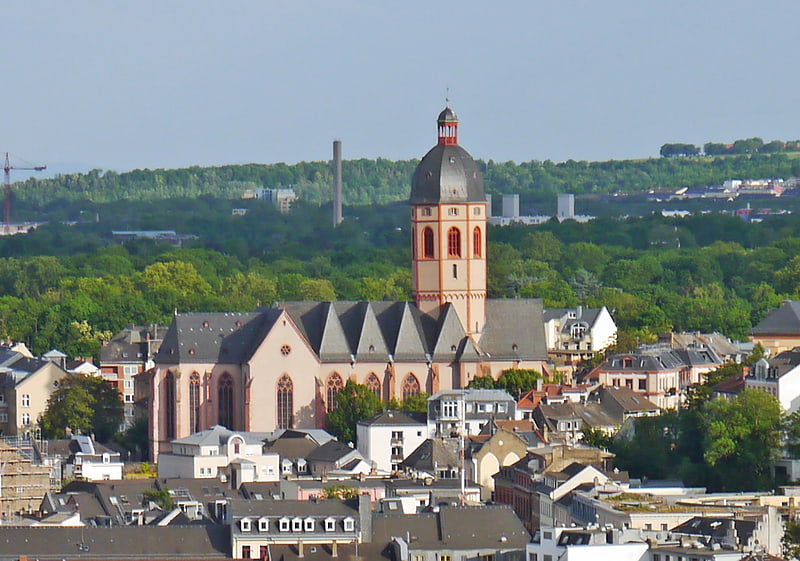
Chagall windows and a late-Gothic cloister. The Collegiate Church of St. Stephan, known in German as St. Stephan zu Mainz, is a Gothic hall collegiate church located in the German city of Mainz. It is known for windows created by Marc Chagall.[5]
Address: Kleine Weißgasse 12, 55116 Mainz
Liebfrauenplatz
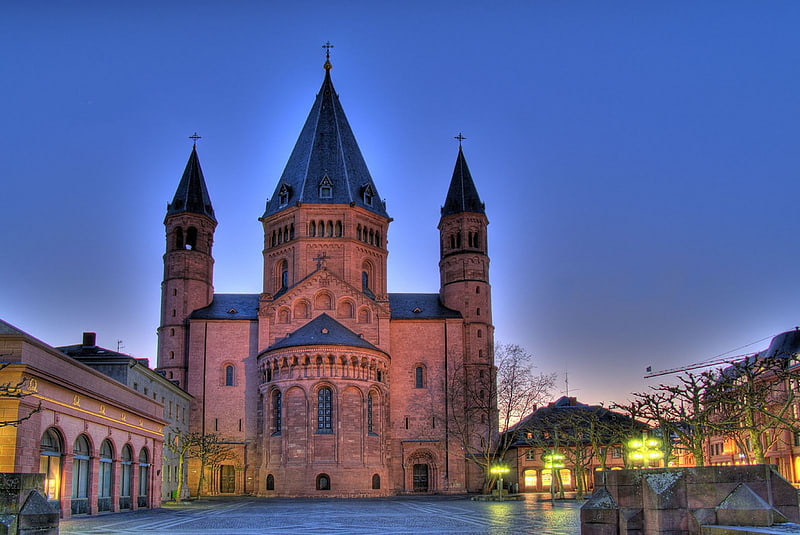
Tourist attraction in Mainz, Germany. The Liebfrauenplatz in Mainz is the easternmost of the four squares around Mainz Cathedral. It originally housed the Liebfrauenkirche, which was demolished at the beginning of the 19th century and whose outline can still be seen today on the square, and marks the transition between the cathedral and the Rhine in the direction of the Fischtor, one of the eastward city gates.[6]
Kurfürstliches Schloss

17th-century palace and conference venue. The Electoral Palace in Mainz is the former city Residenz of the Prince-elector and Archbishop of Mainz. It is one of the important Renaissance buildings in Germany.[7]
Address: Peter-Altmeier-Allee 9, Mainz
Museum für Antike Schifffahrt
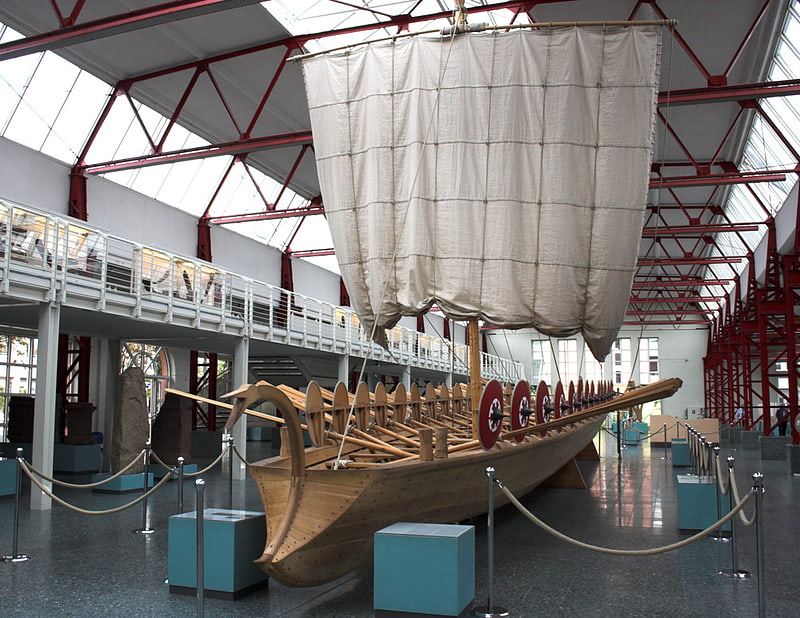
Museum in Mainz, Germany. The Museum of Ancient Seafaring was installed in Mainz in 1994 in the former central covered market near the South Station, nowadays Mainz Römisches Theater station, as a branch of the Romano-Germanic Central Museum. The new archaeological center is built right beside the current museum building. A workshop is affiliated to the museum, where visitors have the opportunity to watch the staff replicate ancient ship models.[8]
Address: Holzhofstraße 2, 55116 Mainz
Christ Church
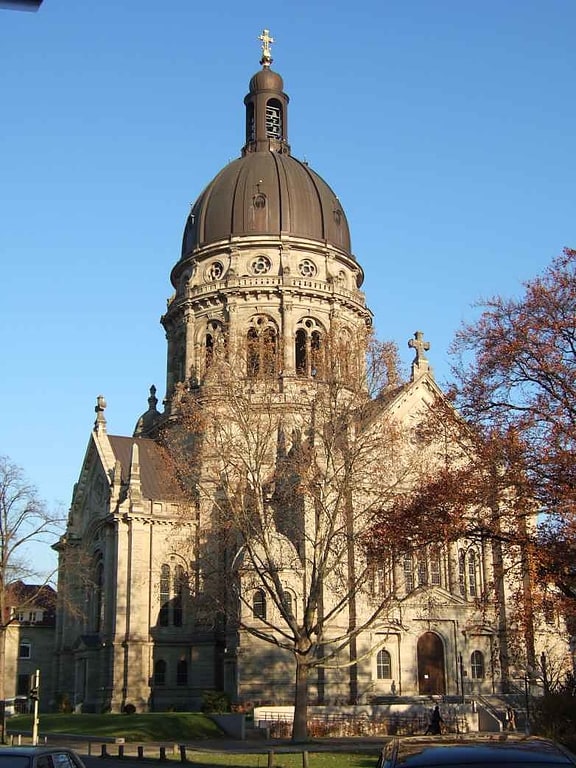
Also known as: Christuskirche
Evangelical church in Mainz, Germany. The Christuskirche is a Protestant church located in Mainz. The Christuskirche was built between 1896 and 1903 designed by Eduard Kreyßig. It was consecrated on 2 July 1903. After demolition during the air raids of World War II the church was reconstructed between 1952 and 1954. The congregation forms part of the Protestant Church in Hesse and Nassau.
In the predominantly Catholic Mainz of 1802, only some hundred Protestants could be traced at the end of the Ancien Régime. Napoleon Bonaparte was the first to grant them the right of freely practising their religion and he expanded their civil rights. Previously Protestants had the status of "tolerated" human beings, a status they shared with the Jews. Around the year 1900 already 33% of the inhabitants of Mainz had the Protestant confession.
Due to increase of the Protestant community, they had to search for new space. The extension of the old city borders by the new expanded town Mainz-Neustadt during the last trimester of the 19th century opened the opportunity to demonstrate the self-confidence of the Protestant community by erecting a new church building. Along with the Kaiserstraße, a new twin lined three-lane boulevard, the church was erected by Eduard Kreyßig, the master builder of Mainz, in Renaissance Revival style. The church was intended to be a representative counterbalance to the Catholic Mainz Cathedral. The mighty dome excels other churches and buildings of the inner city of Mainz.
Besides services, the Christuskirche is shared by lovers of music, since Diethard Hellmann founded in 1954 the Bach Choir and Bach Orchestra to perform especially Bach's cantatas. Fans of Gospel music enjoy the yearly performances of Colours of Gospel. Traditionally the opening mass services of the University of Mainz at the beginning of the academic term take place here.[9]
Address: Kaiserstraße 56, 55116 Mainz
Staatstheater Mainz

Theatre in Mainz, Germany. The Staatstheater Mainz is a theatre in Mainz, Germany, which is owned and operated by the state of Rhineland-Palatinate. Situated on the Gutenbergplatz, the complex comprises two theatres which are connected by an underground passage and also by skywalk. Performances of opera, drama and ballet are presented. Its name was Stadttheater Mainz until 1989.
The main building was constructed between 1829 and 1833 by Georg Moller in Neoclassical style. The construction had been requested by the bourgeoisie of the city of Mainz for decades and cost 280,000 guilders (the city's budget amounted to 300,000 guilders at that time). The theatre's great hall (Großes Haus) was destroyed by bombing during World War II. Friedrich Meyer-Oertel became director of the theatre in 1968. The small hall (Kleines Haus) was built in 1997. Remedial work from 1976 to 1977 aimed at restoring Moller's rotunda were undertaken by Dieter Oesterlen. Between 1998 and 2001, extensive renovations were carried out to restore it to its original condition and it now seats 1,000.
The resident orchestra is the Philharmonisches Staatsorchester Mainz (Philharmonic State Orchestra Mainz).[10]
Address: Mainz, Gutenbergplatz
Marktbrunnen
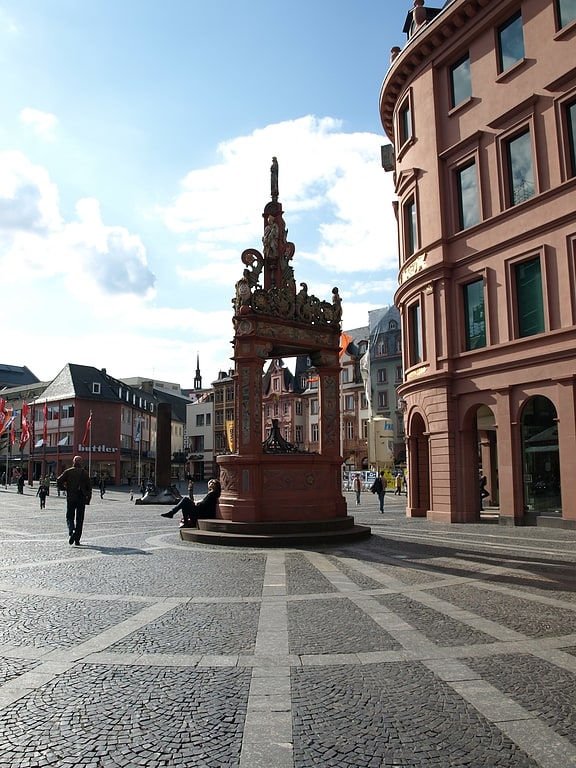
Historical landmark in Mainz, Germany. The Marktbrunnen in Mainz is a renaissance fountain located at the ″Markt″ of Mainz. It was donated by elector Albert of Mainz and crafted in the workshop of the Mainz sculptor Hans Backoffen. The Marktbrunnen represents one of the first architectural formed decorated fountains of the renaissance.[11]
St. John's Church

Also known as: St. Johannis
St. John's Church is located beneath Mainz Cathedral in the historical center of Mainz, Germany. This 1100-year-old church was the first episcopal see of the Bishop of Mainz. It is the oldest church in Mainz, the oldest cathedral in the Germany of today and the only preserved cathedral building from late Carolingian and early Ottonian time in Germany.
St. John's Church is predominantly Carolingian in style, but later exterior additions over many centuries have resulted in the appearance of various architectural influences seen today. It comprises three naves and stands under the patronage of John the Baptist today. It can be assumed that the church was dedicated initially to Martin of Tours since Martin is the Patron saint of the Roman Catholic Diocese of Mainz, then to St. Salvator, consecrated in 911 by Archbishop Hatto I and served as the cathedral for the Bishop of Mainz until the appointment of Willigis as Archbishop of Mainz in 975. It is documented that archbishop Erkanbald was buried in this first cathedral. In 2019, a sarcophagus was opened to gain more information on the early history of the diocese of Mainz. Whether it concerns the remains of cleric Erkanbald, buried in 1021, is investigated since then said research director Guido Faccani.[12]
Bruchwegstadion
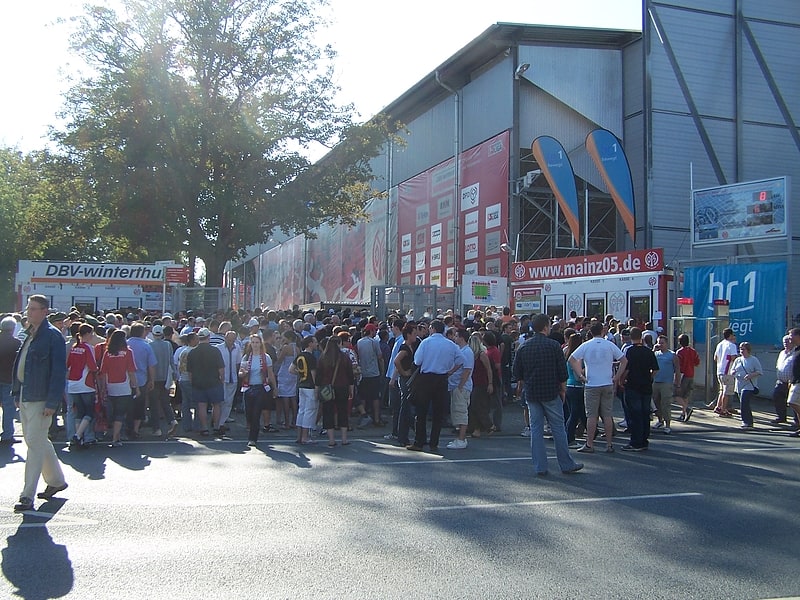
Also known as: Stadion am Bruchweg
Multi-purpose stadium in Mainz, Germany. The Bruchwegstadion is a multi-purpose stadium in Mainz, Germany. It is currently used mostly for football matches. The stadium is able to hold 18,700 people and was built in 1929. It was the home stadium of Bundesliga club Mainz 05 before being replaced by Opel Arena in 2011, known then as "Coface Arena."" It is currently used for youth football matches of Mainz 05.[13]
St. Christoph's Church
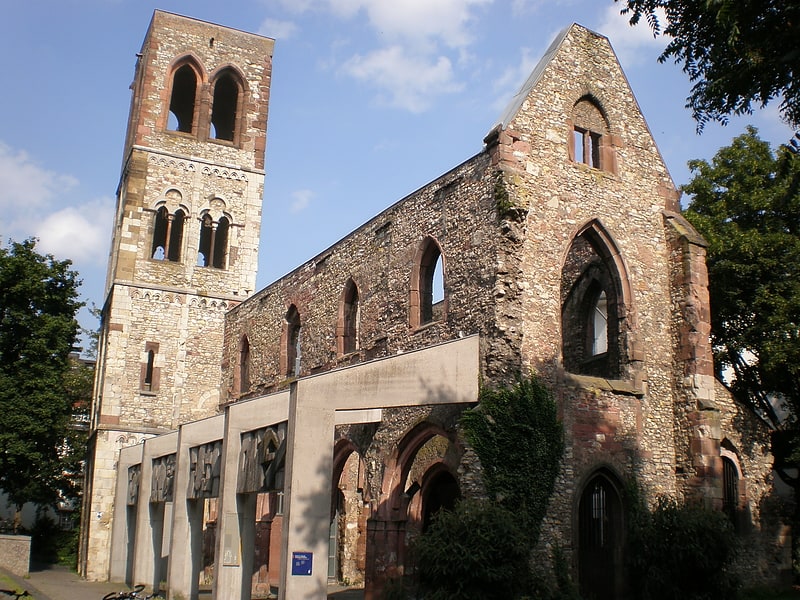
Also known as: St. Christoph
The church of St. Christoph in Mainz, known in German as St. Christoph zu Mainz, is an example of early gothic architecture. St. Christoph was originally built between 1240 and 1330. The church is known as the Parish Church and Baptistry of Johannes Gutenberg.
It had been erected in Christofstraße in the historic city centre of Mainz and adjacent to the Karmeliterplatz. Its ruins represent the central war memorial in the city of Mainz, in memory of the victims and the destruction of the city in World War II, such as the bombing of Mainz on 27 February 1945.[14]
Gutenberg Museum
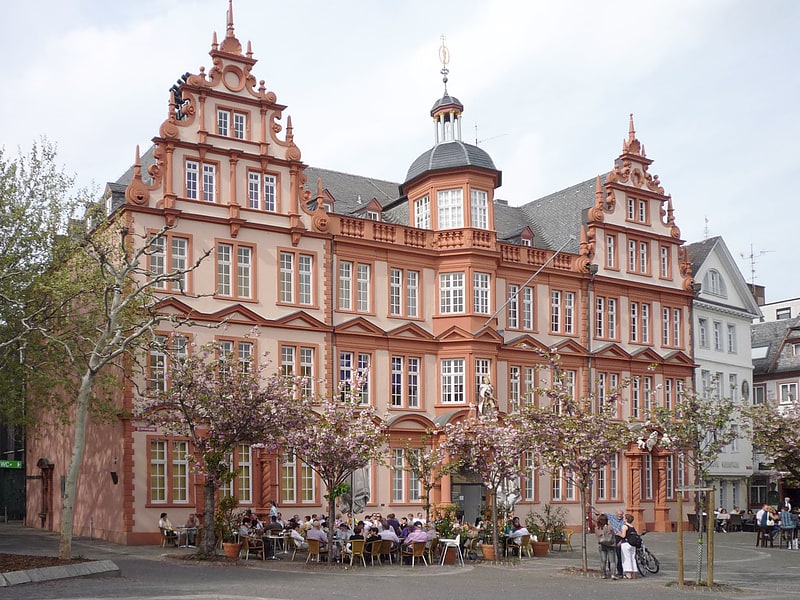
Also known as: Gutenberg-Museum
Museum of the history of printing. The Gutenberg Museum is one of the oldest museums of printing in the world, located opposite the cathedral in the old part of Mainz, Germany. It is named after Johannes Gutenberg, the inventor of printing from movable metal type in Western Europe. The collections include printing equipment and examples of printed materials from many cultures.[15]
Address: Liebfrauenpl. 5, 55116 Mainz
St. Peter's Church
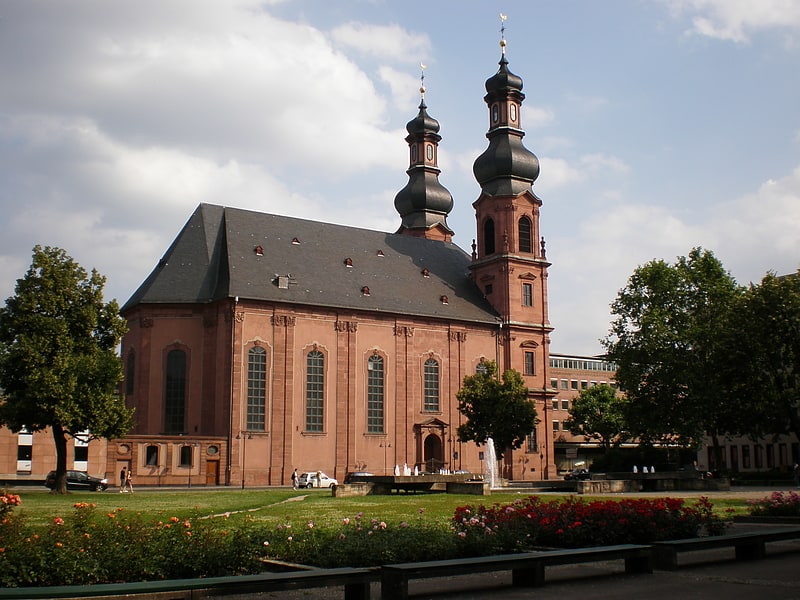
Also known as: St. Peter
Building in Mainz, Germany. St. Peter's Church is located beneath Deutschhaus Mainz in the northwest of the historical center of Mainz, Germany. It is the one of the most important rococo buildings in Mainz. Originally it was a collegiate church monastery of ″St. Peter before the walls″, which had existed since the 10th century and is dedicated to the apostle Peter as patron. Today it serves as a parish church for the parish of St. Peter / St. Emmeran.[16]
Address: Petersstraße 3, 55116 Mainz
Landesmuseum Mainz

Museum with art and local history displays. The Landesmuseum Mainz, or Mainz State Museum, is a museum of art and history in Mainz, Germany. In March 2010 it reopened in full after an extensive renovation.
The museum has its roots in a painting collection donated by Napoleon and Chaptal to the city of Mainz in 1803. It moved into its current location, in the former electoral stables, in 1937, by which time it had grown significantly. It received its present name in 1986, and was renovated and modernised from 2004 to 2010.[17]
Address: Große Bleiche 49-51, 55116 Mainz
Römisch-Germanisches Zentralmuseum
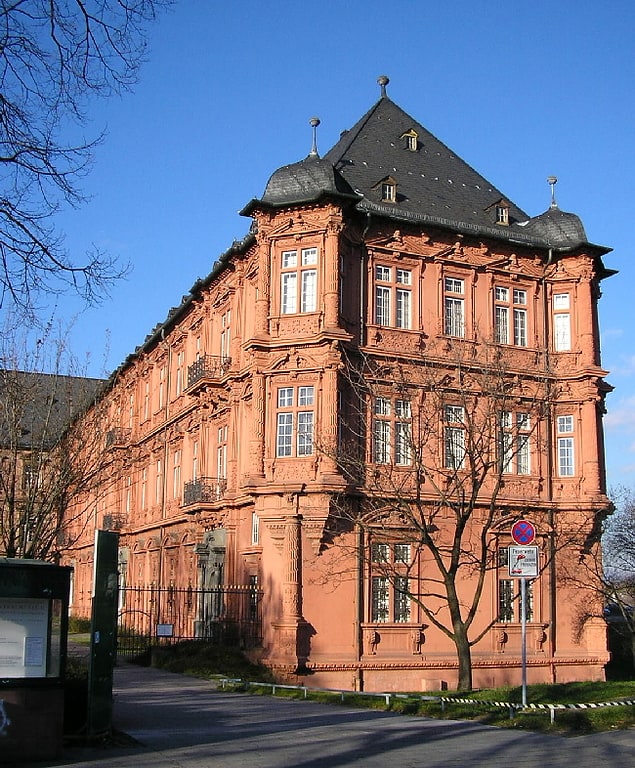
Research institute in Mainz. The Römisch-Germanisches Zentralmuseum, Leibniz Research Institute for Archaeology, is headquartered in Mainz. It is supported by the Federal Republic of Germany and its states and is a member of the Leibniz Association of German research institutions.
The institution studies the Old World and its contact zones from the Stone Age to the Middle Ages. It consists of several divisions, and in addition maintains a permanent collection and through this and its numerous publications and conferences, disseminates the findings of recent research to the public.[18]
Address: Ernst-Ludwig-Platz 2, 55116 Mainz
Südbrücke
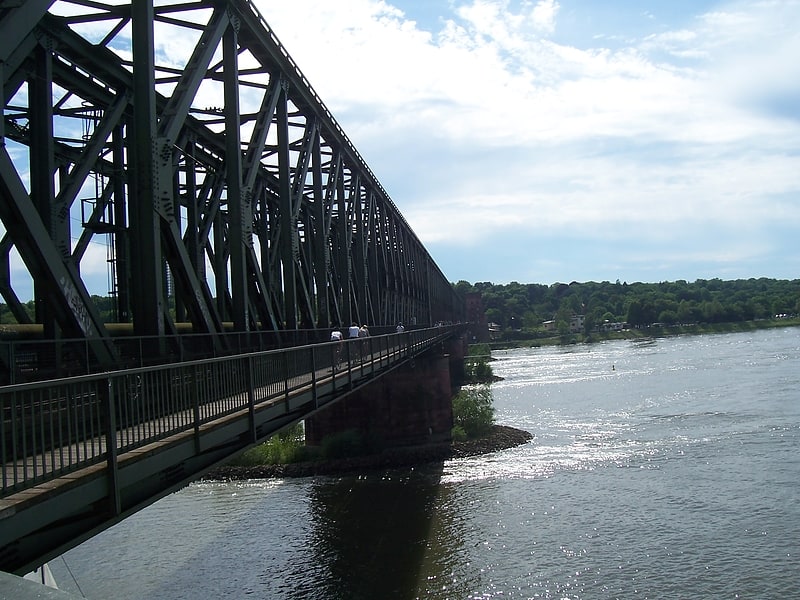
Truss bridge in Mainz, Germany. The Südbrücke, Mainz is a railway bridge on the Main Railway that connects Mainz, Rhineland-Palatinate, across the Rhine with Gustavsburg in Hesse. It is one of the early railway bridges in Germany.[19]
Augustinerkirche

The church of St. Augustin known in German as Augustinerkirche, was the minster of the Augustine friars in the city centre of Mainz. Today it is the seminary church of the Catholic theological seminary of the Roman Catholic Diocese of Mainz.[20]
Address: Augustinerstraße 34, Mainz
Old Jewish Cemetery
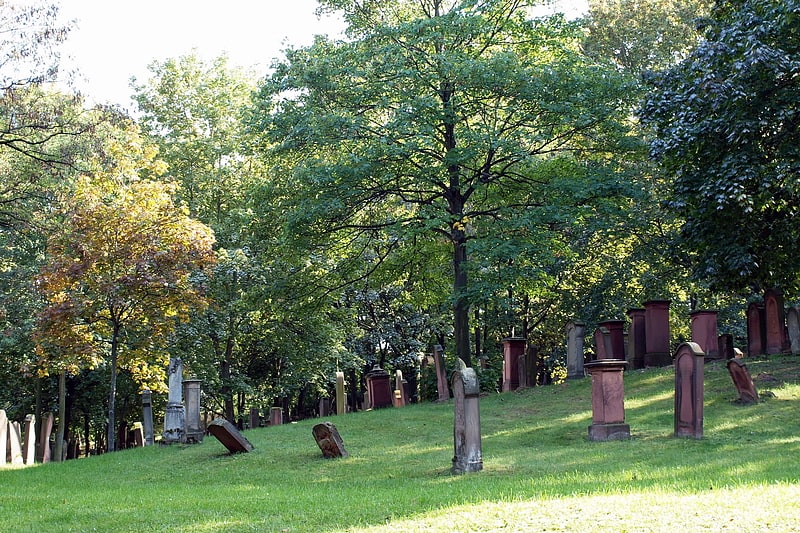
Also known as: Alter Jüdischer Friedhof
The Jewish Sand is the oldest known burial place of the Jewish community in Magenza, Jewish Mainz. Along with the Holy Sand in Worms, it is considered the oldest Jewish cemetery in Europe. Since July 27, 2021, it has been a UNESCO World Heritage Site as part of the Jewish cultural sites of the so-called SchUM cities of Speyer, Worms and Mainz.
New synagogue Mainz
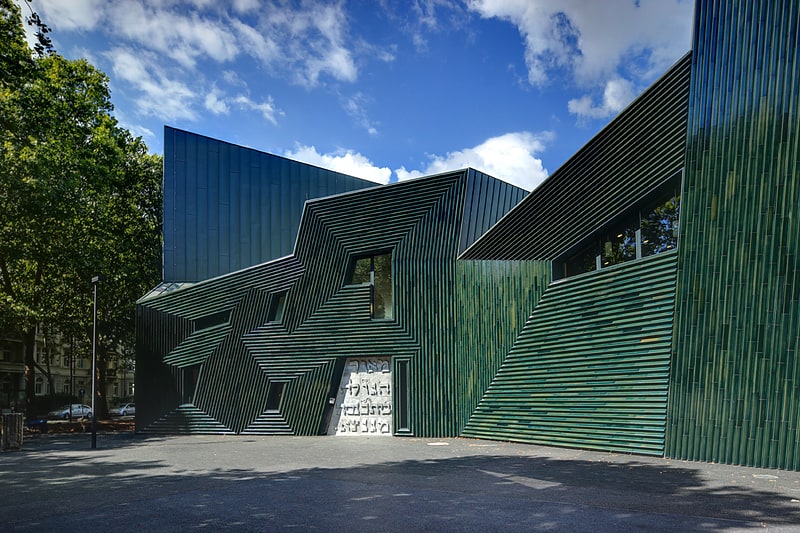
Also known as: Neue Synagoge Mainz
Synagogue. The new synagogue of Mainz is in use since 2010 as a community center at the location of the former main synagogue on the Hindenburgstraße of Mainz Neustadt. Due to controversial discussions regarding the street name, the location in the Hindenburgstraße was renamed as Synagogenplatz.[21]
Iron Tower
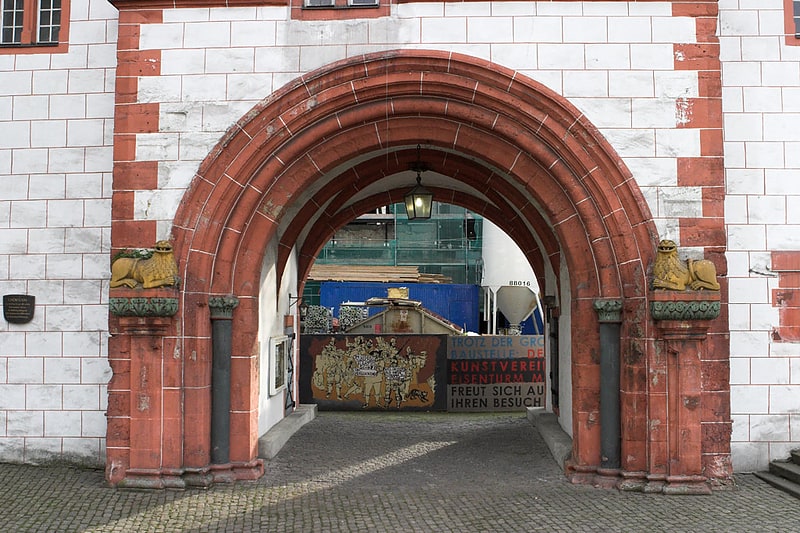
Also known as: Eisenturm
Tower in Mainz, Germany. The Iron Tower is a mediaeval tower dating to the early 13th century, and modified in the 15th century, which with the Wood Tower and the Alexander Tower is one of three remaining towers from the city walls of Mainz, Germany. Its name derives from the Iron Market, which was held in the immediate vicinity until the 19th century.
The Iron Tower served as a watchtower and gate to the city, and later as a gaol. It was badly damaged in World War II and reconstructed in the 1960s. Today it houses various organizations and art projects and is used for art exhibitions.[22]
Address: 1 Fritz-Arens-Platz, Mainz
Mainzer Domchor

The choir Mainzer Domchor is the choir at Mainz Cathedral, of boys' and men's voices. It was founded in 1866 by the then bishop of Mainz, Wilhelm Emmanuel von Ketteler.[23]
Botanischer Garten Mainz
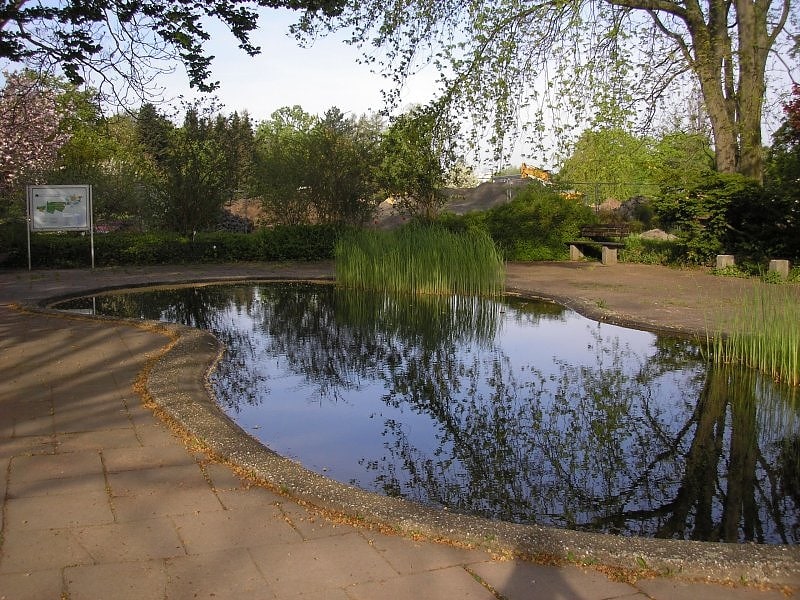
Botanical garden in Mainz, Germany. The Botanischer Garten der Johannes Gutenberg-Universität Mainz, also known as the Botanischer Garten Mainz, is an arboretum and botanical garden maintained by the University of Mainz. It is located on the university campus at Franz von Bentzel-Weg 9, Mainz, Rhineland-Palatinate, Germany, and open daily.
The garden was created between 1946-1955 on land formerly used as farmland and a military training ground. Over 3500 individual plant beds were created in those years; in the mid-1950s an alpine garden was added, and in 1986 sections for steppe plants and Mainz regional flora were established. The first greenhouse was built in 1948 with two more added in 1952, which formed the basis for an extensive greenhouse complex.
Today the garden contains about 8,500 species. Its major sections include an arboretum (30,000 m²), systematic garden, greenhouses, and alpine garden, with outdoor collections focusing on flowering plants and woody plants of the northern hemisphere temperate zone, and a greenhouse complex containing plants from Mediterranean climates and the Southern Hemisphere as well as tropical and subtropical crops.[24]
Address: Anselm-Franz-von-Bentzel-Weg 9a, 55128 Mainz
Altmünster
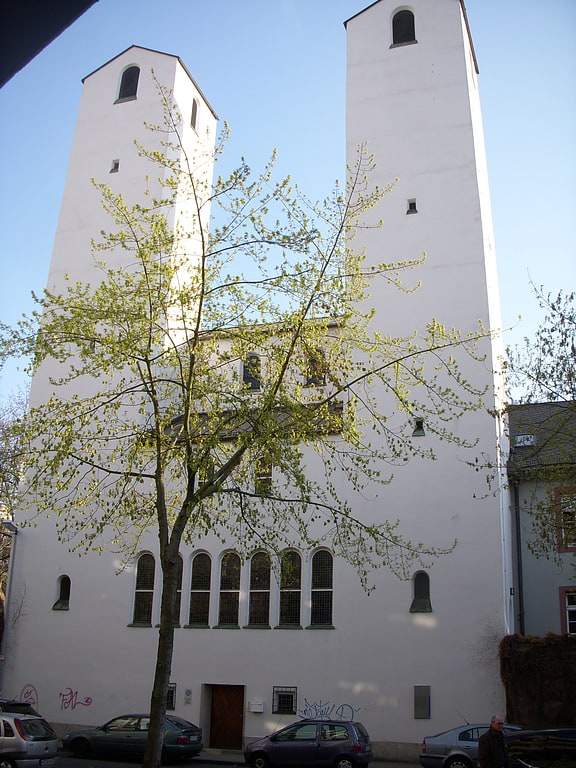
Abbey. The Altmünster abbey near Mainz, Germany, was reputedly founded by Saint Bilihildis, who served as the first abbess; however, it may well be a 7th-century foundation. Though founded as a Benedictine abbey, it adopted the rule of the Cistercians in the 13th century. It was dissolved during the secularization of the 18th century, and the abbey buildings were demolished. The abbey church was given to a Protestant congregation in the early 19th century; it was destroyed during World War II but rebuilt and reconsecrated.[25]
Address: Münsterstraße 25, 55116 Mainz
Bischofsheim
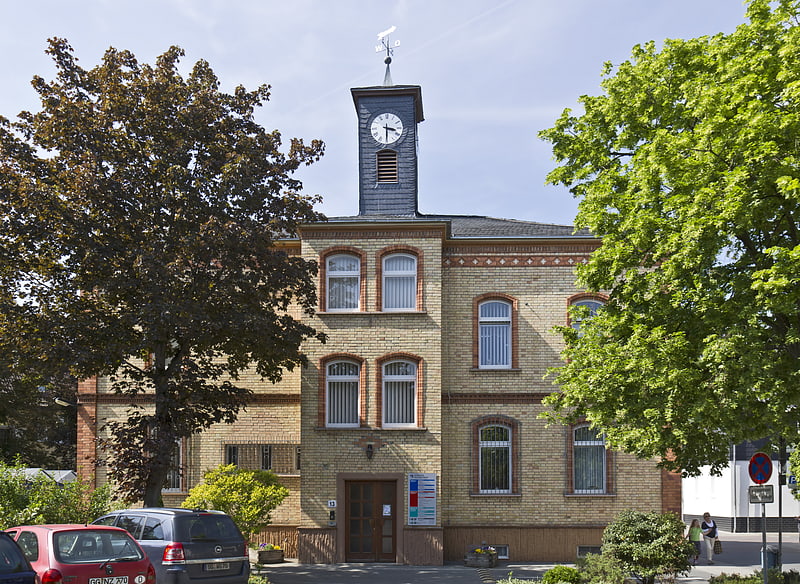
Municipality in Germany. Bischofsheim is a municipality in Groß-Gerau district in Hesse, Germany with a population of more than 13,000.[26]
Eltzer Hof
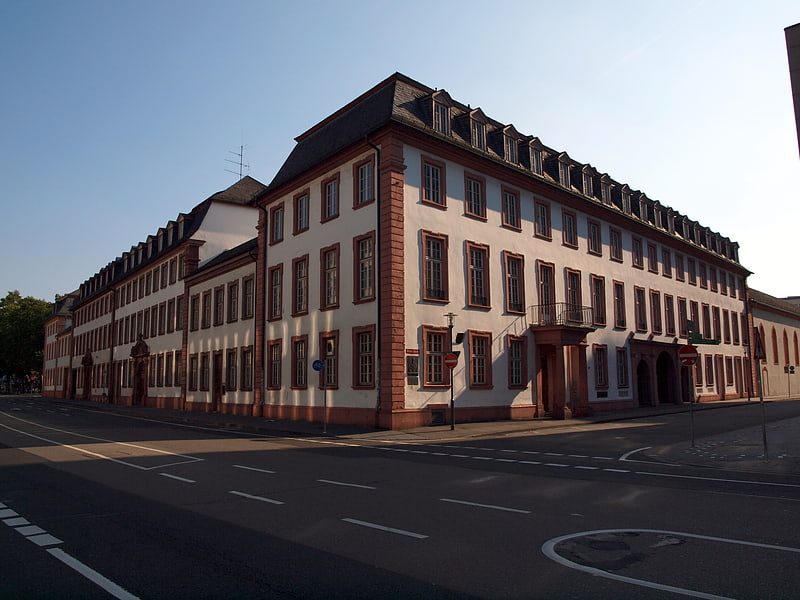
Eltzer Hof was a music venue located in Mainz, Germany. The building was constructed in 1742 in a Baroque style architecture on behalf of the Eltz dynasty. During the Bombing of Mainz in World War II the building burnt down starting 11 August 1942. The three-storey eighteen-axle baroque building with a hipped mansard roof, at Bauhofstraße 3/5 corner Mittlere Bleiche, is listed in the list of cultural monuments in Mainz-Altstadt and together with the adjacent buildings forms a monument zone.[27]
Bassenheimer Hof
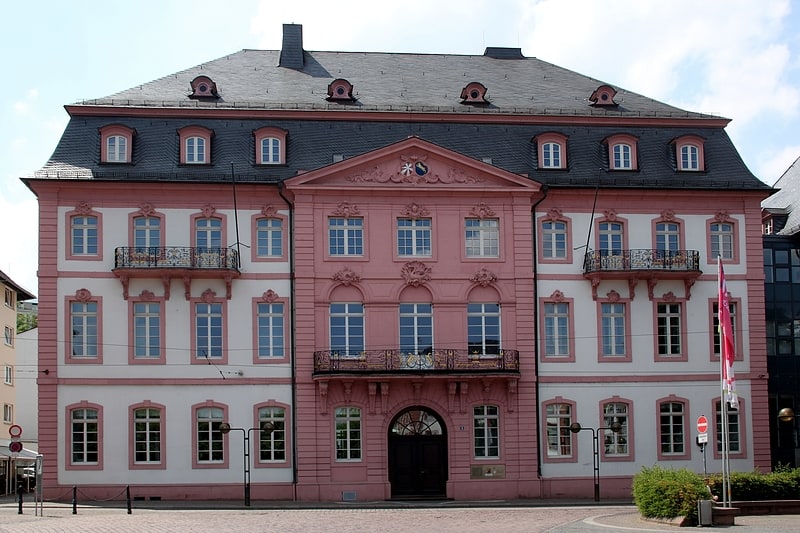
Historical landmark in Mainz, Germany. The Bassenheimer Hof is an historic building in Mainz, western Germany.
At present (2009) the large structure is the seat of the Ministry of the Interior and Sports of the federal state of Rhineland-Palatinate.[28]
Address: Acker 10, 55116 Mainz
Holzturm

Medieval 6-story Gothic stone tower. The Wood Tower is a mediaeval tower in Mainz, Germany, with the Iron Tower and the Alexander Tower one of three remaining towers from the city walls. Its current Gothic appearance dates to the early 15th century. It is so named because wood used to be piled next to it on the bank of the Rhine.
Like the Iron Tower, the Wood Tower was used as a watchtower and gate-tower and later as a gaol. It was badly damaged in World War II and accurately reconstructed in 1961 for the two-thousandth anniversary of the city. It currently houses various organisations and clubs.[29]
Address: Holzstr. 34, 55116 Mainz
Humbrechthof
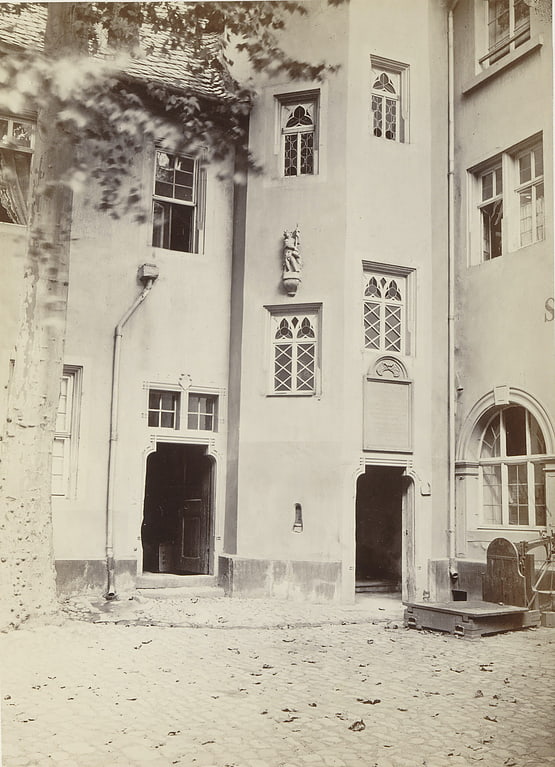
The Humbrechthof, also known as Hof zum Humbrecht, was the building in which Johannes Gutenberg developed his technique of printing with movable metal type and set up his first printing press. It was located in the old town of Mainz. Today, the houses at Schusterstraße 22 and 24 are located on the site.[30]
Sanctuary of Isis and Magna Mater
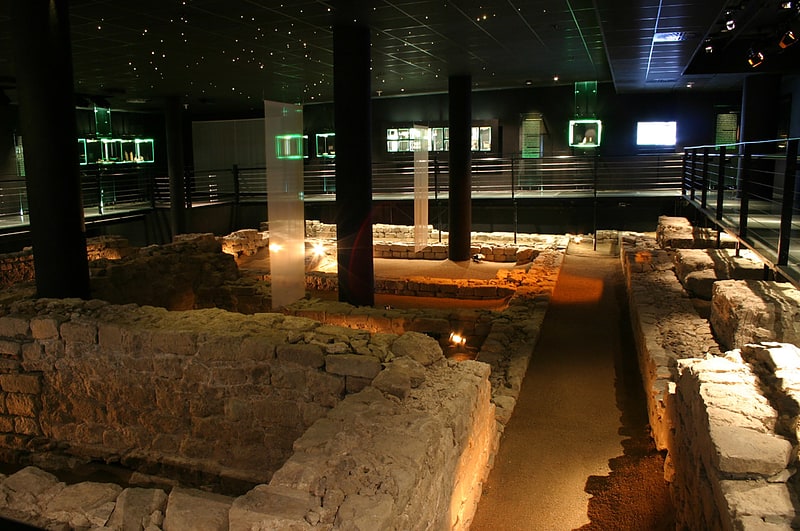
Also known as: Heiligtum der Isis und Mater Magna
Historical landmark in Mainz, Germany. The Sanctuary of Isis and the Magna Mater was a sanctuary in Mainz, dedicated to Isis and Magna Mater.
The temple was founded during the 1st century and remained active until at least the 3rd century. Its remains were discovered in late 1999, during construction of a shopping arcade (later named "Römerpassage") in the city centre. Substantial excavations have been made at the site since. The remains of the building, selected finds, and a multimedia framework presentation can be viewed in a small museum in the basement of the Römerpassage. Consecration inscriptions suggest that the Flavian imperial house may have been involved in the foundation of the sanctuary.[31]
Address: Roemerpassage 1, 55116 Mainz
Drususstein
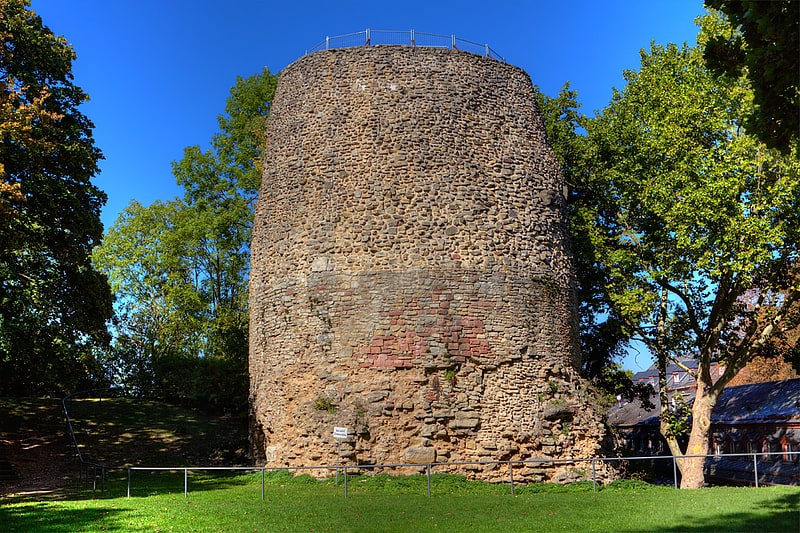
Historical landmark in Mainz, Germany. The Drususstein is a nearly 20 metres high masonry block of Roman origin on the grounds of the citadel of Mainz, Germany. It was originally cased in marble. Researchers now largely accept that this is the structural remnant of the cenotaph mentioned by writers like Eutropius and Suetonius, erected in 9 BC by Roman troops in honour of the deceased general Drusus, in Mogontiacum as part of the Roman funerary art.
During the early days of the Principate the Drususstein was the starting point for elaborate memorial services in honour of Drusus, and the centre of the imperial cult in Mogontiacum. A procession road linked it to the public theater of Mogontiacum, which contained approximately 12,000 seats, making it the largest known theater north of the Alps. It may have hosted a part of the annual ceremonies at the day of Drusus' death, and probably also at his birthday.
After being robbed of its marble casing in the early Middle Ages, the Drususstein served as a watchtower in the fortifications of the city in the 16th century. For that purpose a staircase and doorframe were made in the structure, which had been up to that point a solid building. Besides the pillars of aqueducts and the stage of the theatre, the Drususstein is one of the few remaining visible reminders of Roman Mogontiacum. Together with the Igel Column, it is the only funerary monument north of the Alps dating from antiquity that remains in its original location.[32]
Walk of Fame of Cabaret
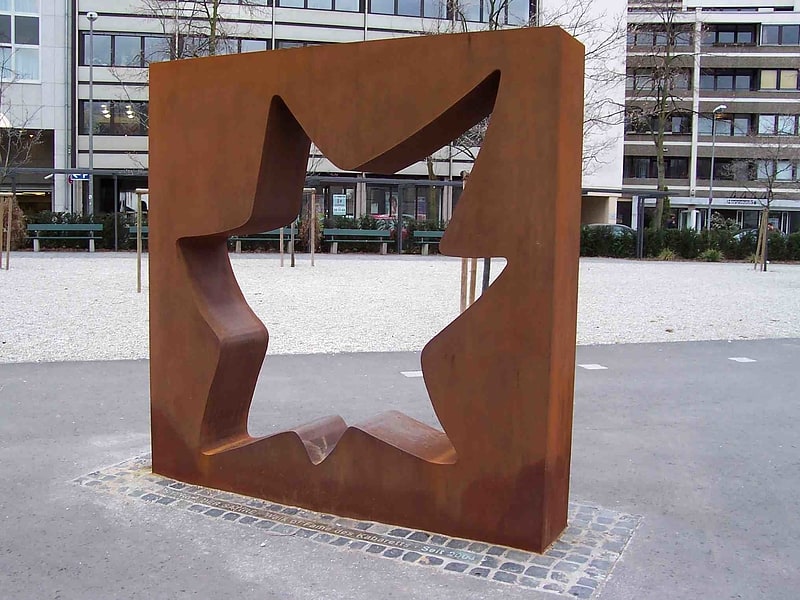
Also known as: Sterne der Satire – Walk of Fame des Kabaretts
The Walk of Fame of Cabaret is a sidewalk between Proviant-Magazin and Schönborner Hof in Mainz, Germany, which is embedded with more than 40 seven-pointed irregularly shaped stars featuring the names of cabaret celebrities selected by a group of experts and honored by several sponsors for their contributions to the cabaret culture.
The first stars, awarded on July 16, 2004, were inaugurated in the presence of Christina Weiss, Culture Representative and Minister of State of Germany and Kurt Beck, the premier of the German federal state of Rhineland-Palatinate. In January 2007, Peter Hammerschlag was honored, and his became the 43rd star on the walk.[33]
Kunsthalle Mainz
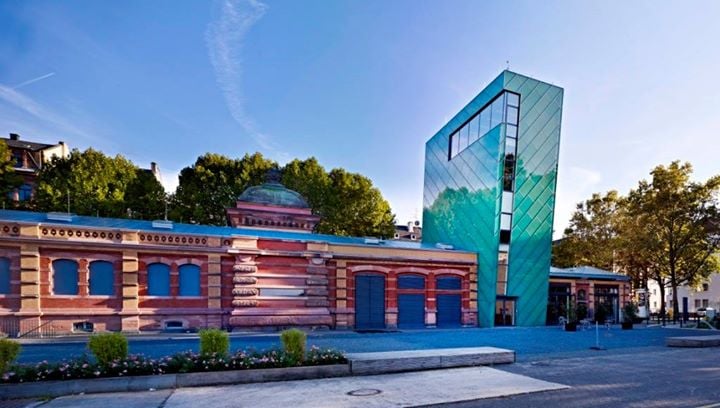
Kunsthalle Mainz is an exhibition center for contemporary art. It is located in the Kessel- und Maschinenhaus in Mainz Zollhafen, which was planned by Eduard Kreyßig in 1887. The building was converted in 2006 by the Mainzer Stadtwerke. The former energy center of the customs port has served as an art gallery since its opening on March 1, 2008.
Address: Am Zollhafen 3-5, 55118 Mainz